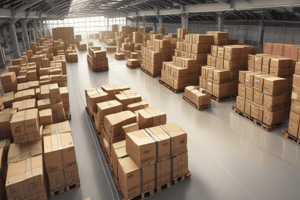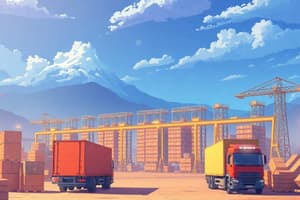Podcast
Questions and Answers
Which of the following is NOT a key benefit of Supply Chain Management (SCM) identified in the provided text?
Which of the following is NOT a key benefit of Supply Chain Management (SCM) identified in the provided text?
- Cost Reduction
- Increased Market Share (correct)
- Revenue Growth
- Improved Effectiveness
Globalization primarily decreases economic and political risk for businesses.
Globalization primarily decreases economic and political risk for businesses.
False (B)
Name three of the six major external forces driving change in supply chains, as identified in the provided text.
Name three of the six major external forces driving change in supply chains, as identified in the provided text.
Globalization, Technology, Empowered Consumers
The shift towards managing both inbound and outbound logistics together led to the development of ______.
The shift towards managing both inbound and outbound logistics together led to the development of ______.
Match the supply chain flow with its corresponding description:
Match the supply chain flow with its corresponding description:
Which of the following best describes the primary focus of supply chain activities during the 1960s?
Which of the following best describes the primary focus of supply chain activities during the 1960s?
Effective SCM typically decreases the opportunity to reduce inventory levels.
Effective SCM typically decreases the opportunity to reduce inventory levels.
What is the main aim of Supply Chain Management?
What is the main aim of Supply Chain Management?
According to one of the studies, the best-in-class companies spent ______ cents of every sales/revenue dollar for supply chain-related costs.
According to one of the studies, the best-in-class companies spent ______ cents of every sales/revenue dollar for supply chain-related costs.
What term refers to a phenomenon where small fluctuations in consumer demand lead to larger distortions in demand forecasts and inventory levels as they move up the supply chain?
What term refers to a phenomenon where small fluctuations in consumer demand lead to larger distortions in demand forecasts and inventory levels as they move up the supply chain?
Flashcards
Supply Chain's Role
Supply Chain's Role
Ensuring the efficient flow of goods, services, and information in private, public, and non-profit sectors.
Forces Driving Change
Forces Driving Change
Technological advancements, globalization, sustainability, demographic shifts, and evolving consumer expectations.
Globalization's Impact
Globalization's Impact
It creates greater economic and political risk, shortens product life cycles, and blurs organizational boundaries.
Inventory Challenges
Inventory Challenges
Signup and view all the flashcards
Power Shifts
Power Shifts
Signup and view all the flashcards
Empowered Consumers
Empowered Consumers
Signup and view all the flashcards
Sustainability
Sustainability
Signup and view all the flashcards
1960s Supply Chain Focus
1960s Supply Chain Focus
Signup and view all the flashcards
Supply Chain Management
Supply Chain Management
Signup and view all the flashcards
Supply Chain Flows
Supply Chain Flows
Signup and view all the flashcards
Study Notes
Supply Chains
- Supply chains enable the efficient flow of goods, services, and data, which is vital for the success of private, public, and non-profit organizations
- Private sector supply chains maintain competitiveness, reduce costs, and ensure customer satisfaction
- Public sector government rely on supply chains to deliver public services
- Non-profits rely on supply chains to deliver aid and resources
Forces Driving Change
- Technological advancements, globalization, sustainability concerns, demographic shifts, and evolving consumer expectations are major forces shaping industries, societies, and economies today
Evolution of Supply Chain Management (SCM)
- SCM has evolved over the years through technological advancements, globalization, and changing business strategies
Supply Chain Challenges
- Organizations face supply chain challenges impacting efficiency, resilience, and profitability due to technological advancements, geopolitical shifts, and environmental concerns
Globalization
- Globalization increases economic and political risk, shortens product life cycles, and blurs organizational boundaries
Business Environment Volatility
- Business Environment Volatility includes acts of terrorism, climate change, and pandemics
Inventory Management Challenges
- Inventory Management Challenges include faster duplication of products and services, faster reduction in demand, new pricing policies, and higher risk of obsolescence
Technology
- Technology facilitates internal processes and supply chain transformation, and significantly changes the marketplace
Social Networks
- Social networks impact customer demand and information transfer speed
Organization Consolidation and Power Shifts
- Economic power in supply chains is shifting from product manufacturers to the retail sector
Empowered Consumers
- Consumers can now access many product sources, have more information, and have increased buying power due to higher incomes
Consumer Demands
- Consumers now demand competitive prices, high-quality and customized products, and convenience and responsiveness (24/7 availability)
Government Policy and Regulation
- Policies, regulations, and taxes impact businesses and their supply chains
Deregulation
- Since the 1970s, deregulation has occurred in transportation, communication, and financial institutions
Sustainability
- Sustainability is recognized as crucial for successful supply chain management, effective risk management, and competitive advantage
Environmental Considerations
- Being "green" and improving the environment is a key objective
Economic Factors
- Continued economic and financial sustainability is important for positive impacts on society and the environment
Supply Chain Concept (1960s)
- Supply chain activities initially focused on outbound logistics, which included the movement of finished goods, transportation, warehousing, and inventory management
Supply Chain Integration
- Companies realized supply chain activities were interconnected; decisions in one area impacted others, prompting businesses to manage these elements as a system
Integrated Logistics Management (1980s)
- Businesses began considering inbound logistics (raw materials into production) alongside outbound logistics as supply chains grew more complex
- Integrated logistics management aimed to optimize the entire supply chain and cost reductions and efficiency improvements comes from looking at logistics holistically
Total Cost and Systems Approach
- The total cost concept became a guiding principle where companies minimized overall logistics costs, and not just individual components
Logistics Functions Integration
- The systems approach integrates logistics functions like transportation, inventory, materials handling, and packaging for efficiency
Supply Chain Management (SCM) Recognition
- SCM became a widely adopted business strategy in the 1990s, due to studies highlighting how companies could gain a competitive edge by integrating and optimizing supply chains
Key Benefits of SCM
- Cost reduction through improved efficiency
- Revenue growth through improved effectiveness and customer service
GMA Study Findings
- A Grocery Manufacturers Association (GMA) study indicated potential savings of $30 billion annually by reducing inventory levels
Supply Chain Council Study
- A Supply Chain Council comparison showed "best-in-class" companies spent 7.0 cents of every sales/revenue dollar on supply chain-related costs, while medium companies spent 13.1 cents
Supply Chain Management Definition
- Supply chain management is coordinating all activities involved in a product's progression, from raw materials to the end customer, optimizing efficiency, quality, and customer satisfaction
Product Flow
- Physical movement of goods and materials involves customers expecting timely, reliable, and damage-free orders, with two-way flows for both delivery to customers and returns
Information Flow
- Exchanging data and communication between supply chain stakeholders ensures efficiency and coordination, with real-time information flow increasing visibility and reducing uncertainty
Cash Flow
- Cash Flow involves the movement of money and payments across the supply chain
Demand Flow
- Demand Flow entails detecting and understanding demand signals to synchronize demand with supply
Supply Chain Complexity
- Supply chains are complex and non-linear, with transportation playing a major role
Supply Chain Networks
- Critical supply chain networks and supporting transportation face challenges from rapid changes
Supply Chain Complexity Factors
- Globalization and consolidation increased complexity with many SKUs, customers, suppliers, and trade regulations
Inventory Deployment Characteristics
- Inventory is often duplicated along the chain, and the bullwhip effect distorts demand forecasts
Information's Role
- Technology leads to vast data collection which can be powerful and substitute inventory by reducing uncertainty if it is timely, accurate, managed, and shared
Cost and Value Considerations
- Preventing sub-optimization is a supply chain challenge, in the environment global supply chains must compete
Organizational Relationships Focus
- Supply chain management emphasizes a horizontal process orientation, requiring collaboration with external entities like vendors and transportation companies
Performance Measurement Purpose
- Organizations use performance measures to analyze efficiency and progress, setting baseline objectives
Technology as Enabler
- Technology improves efficiency, but implementing it effectively is a challenge
Transportation's Role
- Transportation ensures "the right product at the right time, in the right quality and quantity, at the right cost, and the right destination"
Supply Chain Security
- There are increased risks of supply chain disruptions due to globalization
Talent Management Importance
- Educated and talented supply chain managers are needed due to complexity
Globalization Eras
- First era (1400-1800) was driven by countries seeking materials, the second (1800-2000) by companies seeking resources, and the third (since 2000) by individuals using technology
Absolute and Comparative Advantage
- Europe's industrial revolution created the awareness of international trade
Increase in Labor Efficiency
- Specialization increases labor efficiency, but can make the work monotonous and boring
- Technological advancements may lead to a decline in employment opportunities
Factor Endowment
- Countries with more factors of production compared to others use comparative advantage especially through national conditions
Global Demographics
- Global demographics includes considers population age distribution. Developed countries have lower birth rates and aging populations, and developing nations have young populations
Urbanization
- By 2030, 60% of people are expected to occupy megacities. Urbanization presents both opportunities and challenges
Critical Resources
- Land and resources consist of energy, food, and water and are critical for future development
Technology is a Change Agent
- Technology can enhance efficiency and introduce new competition through business models
Global Interdependence
- Positives include lower prices and more jobs, negatives include disease spread and increased competition
Supply Chain Focus
- Supply chains are interrelated firms delivering products and services to the end customer
Global Trade Agreements
- Global Trade Organizations facilitate multilateral trade by lowering barriers, fueled by FTAs, lifting tariff, quota, and tax limitations
Global Market Success Factors
- Strategies in product development, technology, marketing, manufacturing, and supply chains are needed for global market success
World Wide Sourcing
- Global supply chains supply components and source globally
Customer Service Perspective
- Global competition reduces product life cycle, organizational structures and business models will shift to incorporate more outsourcing
Logistics extends to NPOs
- Logistics extends to commercial and non-profit organizations offering the best product/app/website, responsive delivery and marketing
Logistics Management Defined
- Logistics Management consists of planning, implementing, and controlling storage, goods, services, and data, meeting customer requirements
Business Logistics defined
- Business Logistics involves the (forward and reverse) flow including, service and related data, is efficient and effective, using point of use to meet customer requirements
Event Logistics Elements
- Event logistics manages resources to organize, schedule, and deploy and withdraw events
Service Logistics Focus
- Service logistics uses facility, assets, and personnel to have sustainable business operation
Logistics Value Added
- Form/Transformation utility is value added to goods by a manufacturing or assembly process
- Possession utility results through promotion and sales with place, time, and quantity utilities
- Place utility moves goods from production to market, and increases competition extending the market
Time Utility
- TIme Utility adds value having product on had a required time via warehousing and inventory management
Quantity Utility
- Quantity and Place go together, delivering quantity when and where reduces stockout
Macro Logistics
- Logistics costs increases with the amount of products.
Micro Logistics
- Organizational functional boundaries examines a functional organizations relationship/ interaction
Competitive Relationships Affect Logistical Cost
- Order cycle reduces inventory requirement by the customer
Sustainability Affects Logistical Cost
- Customer service adds value for high product usage to reduce cost and lose
Spatial Relationships affect Logistical Cost
- Transportation costs impact fixed points of supply points
Logistical Systems Defined
- Group of parts where focus is on hoe the variables interact. Not just focus on operating individual variables
Studying That Suits You
Use AI to generate personalized quizzes and flashcards to suit your learning preferences.




